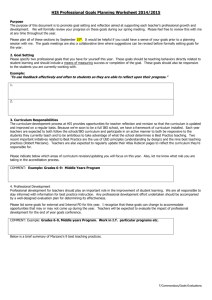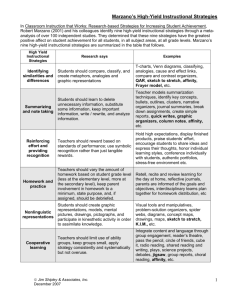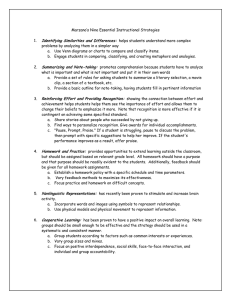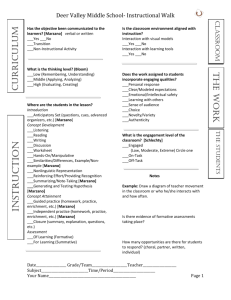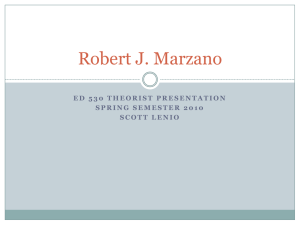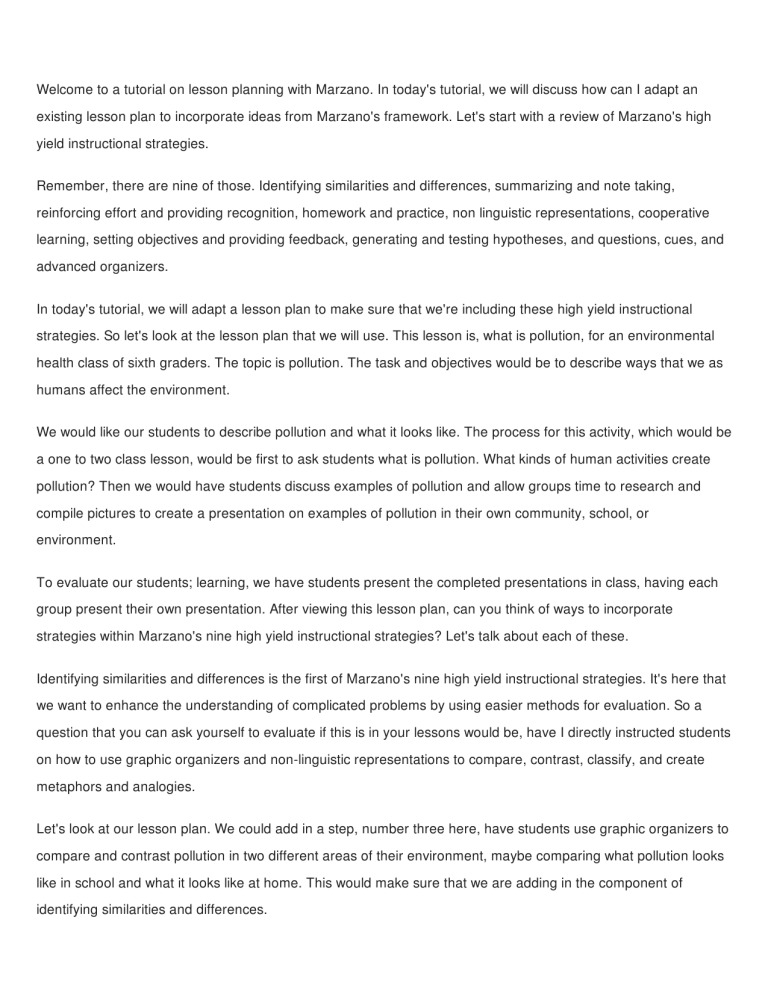
Welcome to a tutorial on lesson planning with Marzano. In today's tutorial, we will discuss how can I adapt an existing lesson plan to incorporate ideas from Marzano's framework. Let's start with a review of Marzano's high yield instructional strategies. Remember, there are nine of those. Identifying similarities and differences, summarizing and note taking, reinforcing effort and providing recognition, homework and practice, non linguistic representations, cooperative learning, setting objectives and providing feedback, generating and testing hypotheses, and questions, cues, and advanced organizers. In today's tutorial, we will adapt a lesson plan to make sure that we're including these high yield instructional strategies. So let's look at the lesson plan that we will use. This lesson is, what is pollution, for an environmental health class of sixth graders. The topic is pollution. The task and objectives would be to describe ways that we as humans affect the environment. We would like our students to describe pollution and what it looks like. The process for this activity, which would be a one to two class lesson, would be first to ask students what is pollution. What kinds of human activities create pollution? Then we would have students discuss examples of pollution and allow groups time to research and compile pictures to create a presentation on examples of pollution in their own community, school, or environment. To evaluate our students; learning, we have students present the completed presentations in class, having each group present their own presentation. After viewing this lesson plan, can you think of ways to incorporate strategies within Marzano's nine high yield instructional strategies? Let's talk about each of these. Identifying similarities and differences is the first of Marzano's nine high yield instructional strategies. It's here that we want to enhance the understanding of complicated problems by using easier methods for evaluation. So a question that you can ask yourself to evaluate if this is in your lessons would be, have I directly instructed students on how to use graphic organizers and non-linguistic representations to compare, contrast, classify, and create metaphors and analogies. Let's look at our lesson plan. We could add in a step, number three here, have students use graphic organizers to compare and contrast pollution in two different areas of their environment, maybe comparing what pollution looks like in school and what it looks like at home. This would make sure that we are adding in the component of identifying similarities and differences. Let's look at summarizing and note taking. Here, we want to give students tools for identifying and understanding the most important aspects of what they're learning, both by summarizing and note taking. We need to ask ourselves, am I modeling summarization techniques. Are my students able to organize key information and eliminate extraneous information? Have I given my students strategies to do this and modeled this for them? To make sure we're adding this to our lesson, we could add in the highlighted areas. In step three, we could add in, after modeling basic note taking and summary writing skills, we would then allow groups time to research and compile pictures to create a presentation. So first, we would model and discuss note taking and summary writing before students research. We could also add in, in step number four, have students write a summary about each area. So not only what they use graphic organizers to compare and contrast, we would also have them put in to words and summarize their ideas. Let's look at the next instructional strategy of reinforcing effort and providing recognition. It's here that we want to teach connection between hard work and high levels of performance. And we can ask ourselves, do I reward based on standards of performance. It's important to note that rewards should not always be tangible, but we should really make sure that we're praising and encouraging our students by sharing ideas, or conferencing. So looking at our lesson, we could add in these steps. During the presentations, we could have students evaluate presentations, maybe writing down two things they learned, two things that groups did well, and two suggestions. We could also set up teacher conferences with each group to review our evaluations. Let's look at the next strategy of homework and practice. It's here we want to extend learning and practice outside the classroom day. You could ask yourself, am I sending home appropriate homework, have I differentiated homework for my students, am I sending home homework that is independent, or am I frustrating my students. Is it at that frustration level? We also need to make sure that we're keeping our parents informed of homework, and giving them ideas of how they can support our students' learning at home. Let's look at our lesson. In step three, after modeling basic note taking and summary writing skills, we've allowed our groups time to research and compile pictures to create a presentation. We might also add to this step, ask students to research for homework bringing in two to three new ideas each class. Let's look at the next strategy of non-linguistic representations. It's here that we want to demonstrate relationships using words, visuals, and symbols. You can ask yourself, do I allow students to create graphic representations, do I provide opportunities for hands-on learning. Let's look at our lesson. After students are given the opportunity to do some research, we could give each group a class camera and maybe take a field trip around school grounds to document pollution examples. This would be a very hands-on activity where we're using a tool to document information aside from hearing it verbally. Our next area of cooperative learning, we want to promote collaboration and positive social skills in our classroom. We can ask ourselves, am I being intentional in my groupings, am I teaching students how to work in groups. In this particular lesson, we've already done a good job of incorporating group work as a teacher. One thing we might want to think about is making sure that our groups have a good idea of the different roles within a group, so we're always making sure that our group members know what their job is and how their job is contributing to their group. As a whole, we want to make sure that we have positive social skills in our classroom on a daily basis. So this is something we'd be constantly working on. Next, we have setting objectives and providing feedback and here we want to communicate direction and objectives-- clear direction and clear objectives. You can ask yourself, have I created specific goals while also allowing for student choice. Have I allowed for feedback opportunities? Let's look at our lesson. Our task and objectives section was to describe ways that we, as humans, affect the environment and describe pollution and what it looks like. When we include this high yield instructional strategy of setting objectives and providing feedback, we could also add that we want to discuss these objectives before starting this activity. We could use guided questions throughout this activity to find student interests. We could also have students add objectives as determined. Let's look at generating and testing hypotheses. It's here that we want to consider using scientific investigation methods. You can ask yourself, have I provided opportunities for investigation. Looking in our lesson we could add a step telling students about the field trip and research that they will be doing. Before we go on the field trip, we could have students make predictions and form hypotheses. The last of the instructional strategies is questions, cues, and advanced organizers. It's here that we want to help students make connections to prior learning, and you can ask yourself, have I built in cues and questions that focus on what is important. Looking at our lesson, we could add in guided questions throughout our entire lesson. We could also walk around during group time to prompt questions as needed. This would give us, as a teacher, a true idea of what's going on in conversations, and where the ideas are going. What learning is taking place? So let's reflect for a moment. How can we apply these ideas? Can you think of additional ideas to incorporate using Marzano's strategies here? What are the benefits of applying Marzano's high yield instructional strategies to your lessons? Let's talk about what we learned today. How can I adapt an existing lesson plan to incorporate ideas from Marzano's framework? We took Marzano's nine high yield instructional strategies, and a lesson plan that we created, and adapted it based on Marzano's strategies. We made sure we had components of each of the nine high yield instructional strategies within our lesson. It's important to remember that many teachers can misapply the homework aspect of Marzano, so make sure that you really truly understand this aspect of Marzano's model and apply it to your own lessons. Thanks for joining me today. I've enjoyed talking about Marzano's framework and connecting it with this lesson on pollution. I hope you're able to take some of these components and add them to your own lesson planning. Now it's your turn to apply what you've learned throughout this video. The additional resources section will be super helpful. This section is designed to help you discover useful ways to apply what you've learned here. Each link includes a brief description, so you can easily target the resources that you want.
